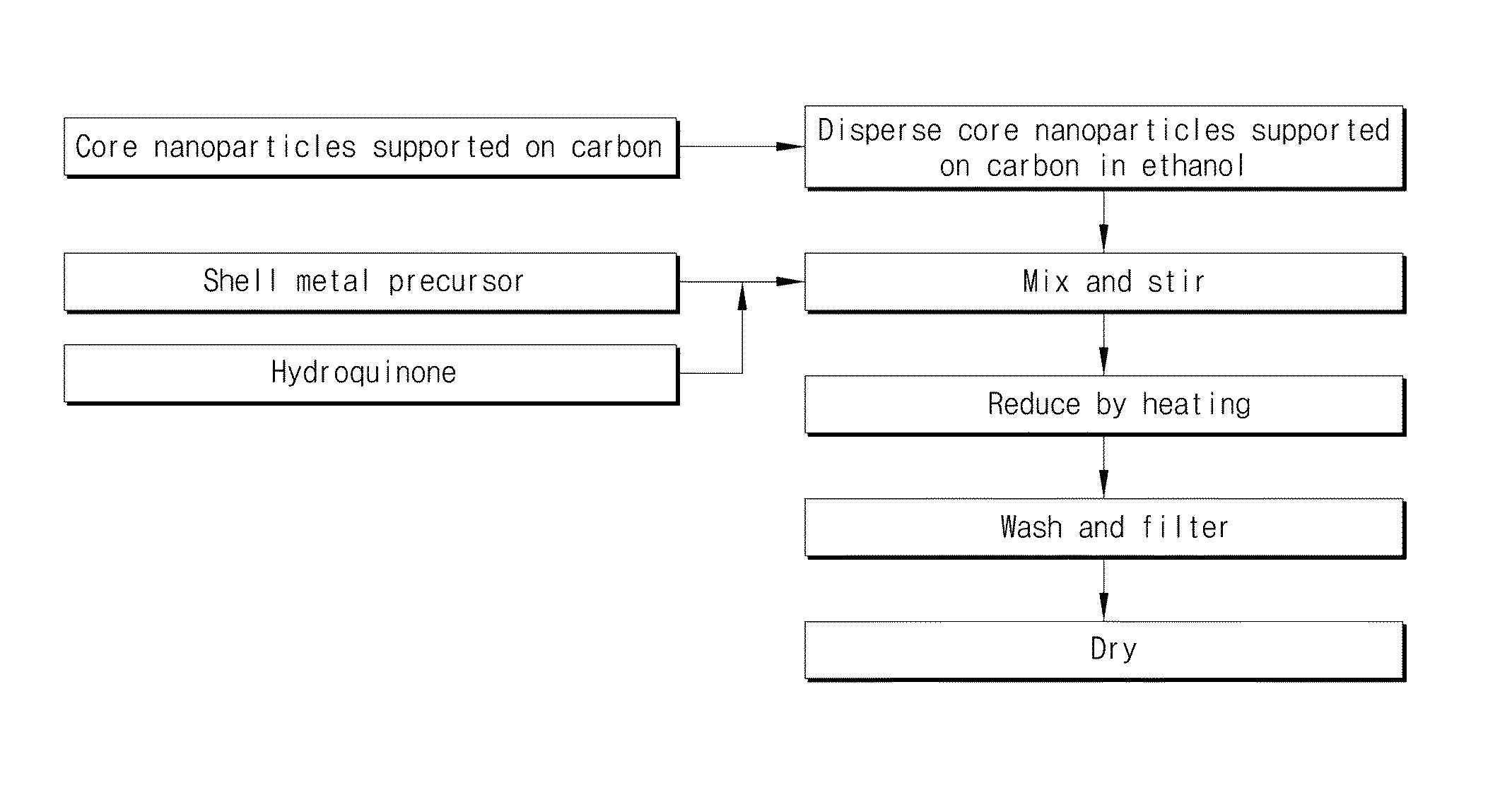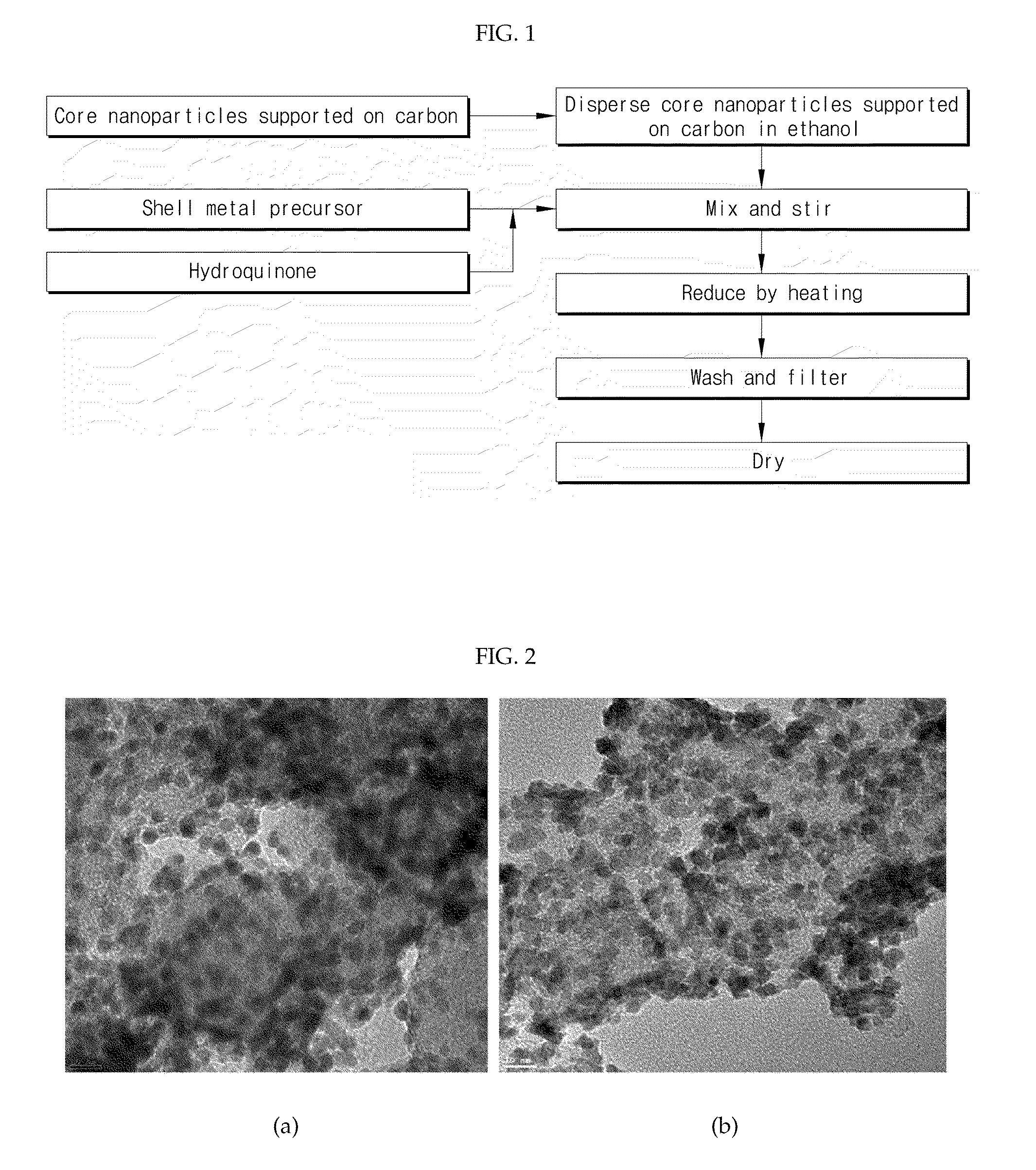Synthesis methods of core-shell nanoparticles on a carbon support
a carbon support and nanoparticle technology, applied in the direction of synthetic resin layered products, metal/metal-oxide/metal-hydroxide catalysts, natural mineral layered products, etc., can solve the problems of reducing the use of platinum or replacing it with other materials, high cost of typical electrode materials platinum, and limited reserves
- Summary
- Abstract
- Description
- Claims
- Application Information
AI Technical Summary
Benefits of technology
Problems solved by technology
Method used
Image
Examples
examples
[0036]The following examples are for illustrative purposes only and not intended to limit the scope of the present invention.
preparation example
Preparation of 28.6 Wt % (Metal Content) Pd / C Nanoparticles
[0037]Oleylamine (TCI, 360 μL) was added to 1,2-propanediol (99.5%, Aldrich, 100 mL) and stirred for 30 minutes. Then, addition of a carbon support (Cabot, Vulcan XC-72R, 0.15 g) was followed by stirring for 30 minutes, ultrasonic dispersing for 30 minutes and then stirring for 30 minutes. Then, palladium acetylacetonate (Pd(C5H7O2)2, 0.1718 g) dissolved in 1,2-propanediol (60 mL) was added to the carbon support solution while stirring. The solution was sufficiently mixed by stirring for over 12 hours. After sufficient mixing, ultrasonic dispersing was carried out for 1-5 minutes before heating the solution. Then, the solution was heated to 110° C. in a reactor under a flowing argon gas atmosphere to prevent penetration of air. After heating for 2 hours at 110° C., 5 molar equivalents of sodium borohydride (NaBH4) based on palladium dissolved in 1,2-propanediol (20 mL) was injected thereto as quickly as possible, while stirr...
example
Preparation of Pd / Pt Core-Shell Nanoparticles Supported on Carbon
[0038]In another example, core-shell nanoparticles were prepared by coating 0.3, 0.5, 0.7, 0.9 and 1.1 mol of Pt, based on 1 mol of Pd, on the 28.6 wt % Pd / C electrode material prepared in Preparation Example. Details are as follows.
[0039]The Pd / C nanoparticles (0.1 g) were added to anhydrous ethanol (water content 1%, 100 mL) and stirred for about 10 minutes, ultrasonically dispersed for 10 minutes, and then stirred again for 10 minutes. Then, hydroquinone (Aldrich) and PtCl4 (Aldrich) dissolved in anhydrous ethanol in a 20 mL vial were added while stirring. After the addition of hydroquinone and PtCl4, anhydrous ethanol was further added to make the final volume 200 mL. The addition amount of PtCl4 was 0.3, 0.5, 0.7, 0.9 and 1.1 mol per 1 mol of Pd. And, the addition amount of hydroquinone was 20 times the mol of Pt. After stirring for at least 3 hours, the mixture solution was heated at 70° C. for 5 hours in a react...
PUM
| Property | Measurement | Unit |
|---|---|---|
| temperature | aaaaa | aaaaa |
| volume | aaaaa | aaaaa |
| particle diameter | aaaaa | aaaaa |
Abstract
Description
Claims
Application Information
 Login to View More
Login to View More - R&D
- Intellectual Property
- Life Sciences
- Materials
- Tech Scout
- Unparalleled Data Quality
- Higher Quality Content
- 60% Fewer Hallucinations
Browse by: Latest US Patents, China's latest patents, Technical Efficacy Thesaurus, Application Domain, Technology Topic, Popular Technical Reports.
© 2025 PatSnap. All rights reserved.Legal|Privacy policy|Modern Slavery Act Transparency Statement|Sitemap|About US| Contact US: help@patsnap.com



